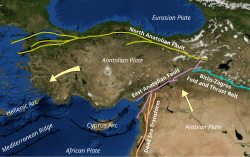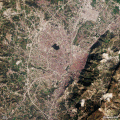2023 Turkey–Syria earthquake
On 6 February 2023 at 04:17 a.m. TRT (01:17 a.m. UTC) there was a very strong earthquake in Gaziantep Province in southeastern Turkey,[3] 34 km (21 mi) west of the city of Gaziantep at 04:17 AM TRT. The maximum Mercalli intensity was XII (Extreme), and a magnitude of 7.8 was given.[4] It was equal to the 7.8 magnitude 1939 Erzincan earthquake as the strongest recorded earthquake to hit Turkey in modern times. Only the 7.8–8.0 magnitude 1668 North Anatolia earthquake was more powerful.[5][6]

| |

| |
| Clockwise from top: Collapsed buildings in Hatay Province, a view of the wreckage from Aleppo, Syria, Chinese Blue Sky and Iranian search and rescue teams in Adıyaman, an assistance of USAID in İncirlik Air Base and a tent city in Kahramanmaraş | |
| Date | {{{date}}} |
|---|---|
| Duration | 80 seconds |
| Magnitude | Mw 7.8 |
| Depth | 10.0 km (6 mi) |
| Epicenter location | Şehitkamil, Gaziantep Province 37°09′58″N 37°01′55″E / 37.166°N 37.032°ECoordinates: 37°09′58″N 37°01′55″E / 37.166°N 37.032°E |
| Type | Strike-slip, supershear, doublet |
| Countries or regions affected | {{{countries affected}}} |
| Max. intensity | XII (Extreme)[1] |
| Tsunami | 17 cm (6.7 in) |
| Aftershocks | ≥10,000 (by 3 March) 516+ with a Mw 4.0 or greater[2] |
| Casualties | 59,259 deaths, 121,704 injured, 297 missing
|

It is the deadliest earthquake in the history of Turkey since the 1268 Cilicia earthquake, and has surpassed the 1939 Erzincan earthquake, which killed 32,700–32,968 people, as the deadliest earthquake of the Republic of Turkey, and it is the deadliest worldwide since the 2010 Haiti earthquake.[7]
After the earthquake, there were several aftershocks. The strongest of them had a magnitude of 7.5 that occurred in Kahramanmaraş.
Casualties
As of 18 February, more than 46,400 deaths have been reported in total; more than 40,600 in Turkey and more than 5,800 in Syria.[8] Most of the aid effort focused on Turkey. There is a civil war in Syria, and accessing the areas affected is more difficult. For this reason, the numbers given for Syria are likely less accurate than those given for Turkey.
Damage
The earthquake is estimated to have caused US$84.1 billion worth of damage in Turkey alone, making it the fourth-costliest earthquake on record, and one of the costliest natural disasters ever recorded.[9]
The Turkish government carried out a damage assessment of 763,000 buildings in 13 provinces affected by the earthquake. It was determined that 41,791 buildings collapsed or were badly damaged and are in urgent need of demolition.[10]
Criticism of the government
Many people have criticized the government. Critics point out the following issues, amongst others:
- Building safety standards in the region are poor.[11]
- Many of the older buildings collapsed, because poor quality building materials were used. Some of the newer buildings collapsed because there were flaws in the engineering.
- After the 1999 İzmit earthquake, new standards were made. These standards dictate, that new building should be made to withstand earthquakes better.[12]
- The building codes were last updated in 2018. These codes now have requirements for engineering design and construction quality as well as material quality.[13]
- The problem is, that when a fee is paid, these standards are not checked. These "construction amnesties" have also been used to get around the checking if the building was different from the original plans; very often, extra floors are added. Up to 75.000 buildings in the earthquake zone have been given such amnesties.[12] Turkish engineers had warned that cities could become 'graveyards' with building amnesty.[14]
- The funds that were meant to protect against natural disasters like this one were instead spent on highway construction projects managed by associates of Erdogan and his coalition government.[15]
- The military was deployed too late, only two days after the event; some say, too few people were deployed. [16]
2023 Turkey–Syria Earthquake Media
Map of the Anatolian Plate, showing location of the East Anatolian Fault
Map showing faults active during the Holocene, the extent of observed or inferred surface rupture and the location of epicenters for all earthquakes in the sequence of magnitude M≥5.0 in the first 21 days
Interferogram of the Mw 7.8 mainshock
Cracked land after the earthquake in Gölbaşı, Adıyaman Province
An example of soil liquefaction and a partially tilted apartment building in Gölbaşı
Wreckage of the collapsed Galeria Business Center, Diyarbakır
Satellite view of the destruction in Antakya
Satellite view of the blaze at İskenderun
Russian aid reaching affected residences of Aleppo, Syria
Notes
References
- ↑ National Earthquake Information Center (6 February 2023). "M 7.8 – 23 km E of Nurdağı, Turkey". United States Geological Survey. Archived from the original on 6 February 2023. Retrieved 6 February 2023.
- ↑ USGS (6 February 2023). "USGS earthquake catalog". Archived from the original on 7 February 2023. Retrieved 7 February 2023.
- ↑ "Huge quake toppled buildings in Turkey and Syria as people slept". BBC News. 6 February 2023. https://www.bbc.com/news/world-europe-64533851.
- ↑ "Major magnitude 7.8 earthquake - 34 km west of Gaziantep, Turkey, on Monday, Feb 6, 2023 at 3:17 am (GMT +2)". Volcanodiscovery.com. 6 February 2023. Retrieved 6 February 2023.
- ↑ "Historic Worldwide Earthquakes". United States Geological Survey. Archived from the original on 25 August 2009.
- ↑ Ambraseys, N. (2009). Earthquakes in the Mediterranean and Middle East: A Multidisciplinary Study of Seismicity up to 1900. Cambridge University Press. pp. 512–515. ISBN 9781316347850.
- ↑ "Timeline: Turkey hit by most devastating earthquake since 1999". Al Jazeera. 6 February 2023. https://www.aljazeera.com/news/2023/2/6/timeline-turkey-syria-earthquakes-most-deadly-since-1999. Retrieved 6 February 2023.
- ↑ (in tr) AFAD: 17 bin 134 kişi hayatını kaybetti, 70 bin 347 kişi yaralandı. https://www.trthaber.com/haber/gundem/afad-17-bin-134-kisi-hayatini-kaybetti-70-bin-347-kisi-yaralandi-745003.html. Retrieved 9 February 2023.
- ↑ (in tr) TÜRKONFED raporu: Depremlerin mali hasarının 84,1 milyar dolar olması bekleniyor. Bloomberg HT. 12 February 2023. https://www.bloomberght.com/turkonfed-raporu-depremlerin-mali-hasarinin-84-1-milyar-dolar-olmasi-bekleniyor-2325161. Retrieved 12 February 2023.
- ↑ (in tr) Deprem sonrası hasar tespit çalışması: 41 bin 791 bina ağır hasarlı. NTV. 2023-02-14. https://www.ntv.com.tr/turkiye/deprem-sonrasi-hasar-tespit-calismasi-41-bin-791-bina-agir-hasarli,6G9BphJI_EOJlkopjqWJSQ. Retrieved 2023-02-14.
- ↑ Sert, Ayşegül (2023-02-08). "Turkey's Trust in Government Has Turned to Dust". The Atlantic. Archived from the original on 2023-02-08. Retrieved 2023-02-11.
- ↑ 12.0 12.1 "Turkey earthquake: Why did so many buildings collapse?". BBC News. 8 February 2023. https://www.bbc.com/news/64568826.
- ↑ Beaumont, Peter (7 February 2023). Turkey earthquake death toll prompts questions over building standards. https://www.theguardian.com/global-development/2023/feb/07/turkey-earthquakes-death-toll-prompts-questions-over-building-standards.
- ↑ Turkish cities could become 'graveyards' with building amnesty, engineers say. 26 February 2019. https://www.reuters.com/article/us-turkey-construction-idUSKCN1QF1VU.
- ↑ https://www.npr.org/2023/02/09/1155647266/turkey-earthquake-erdogan-government-response-criticism
- ↑ "Cüneyt Özdemir Canlı Yayında Askerin Neden Deprem Bölgesinde Olmadığını Sordu". Onedio.









